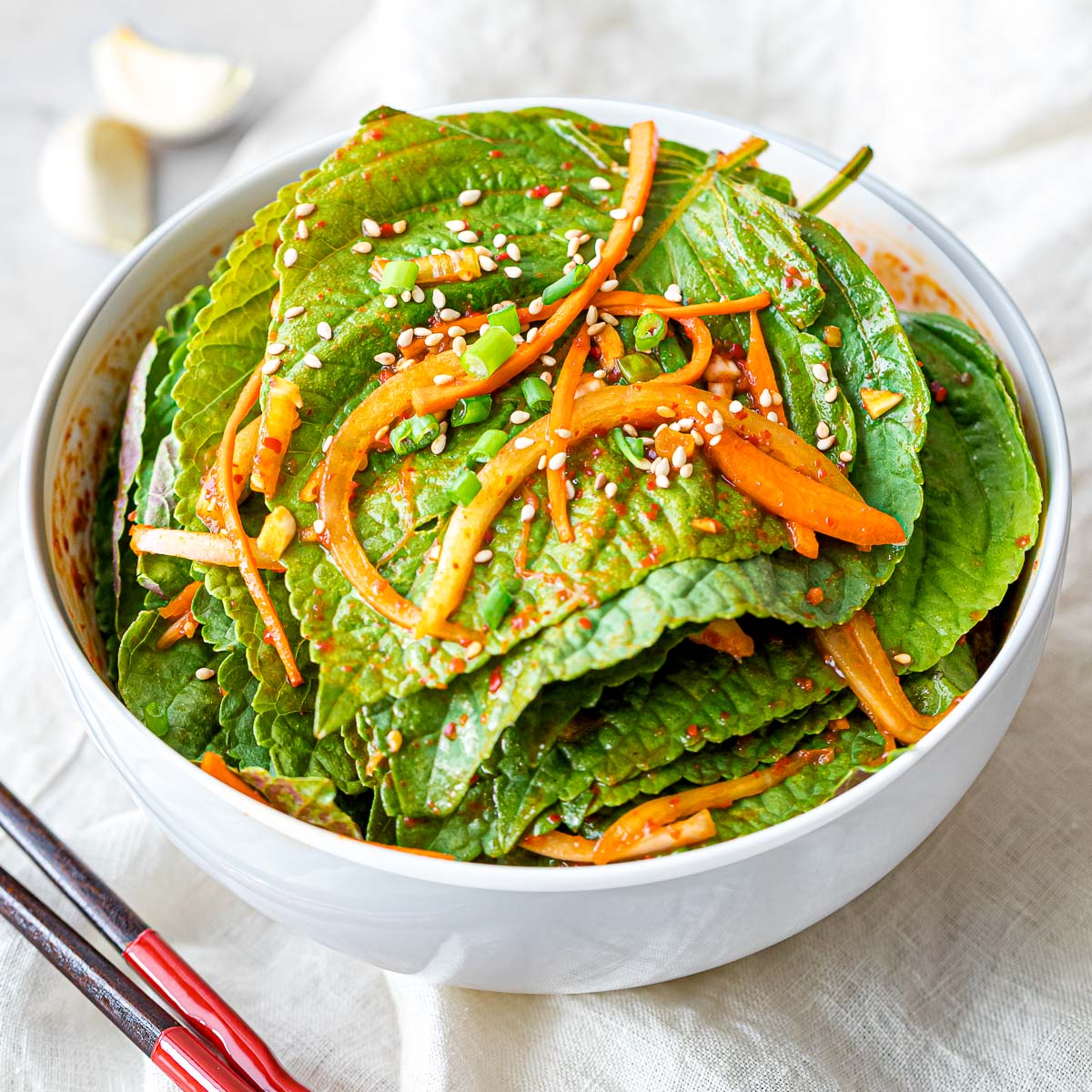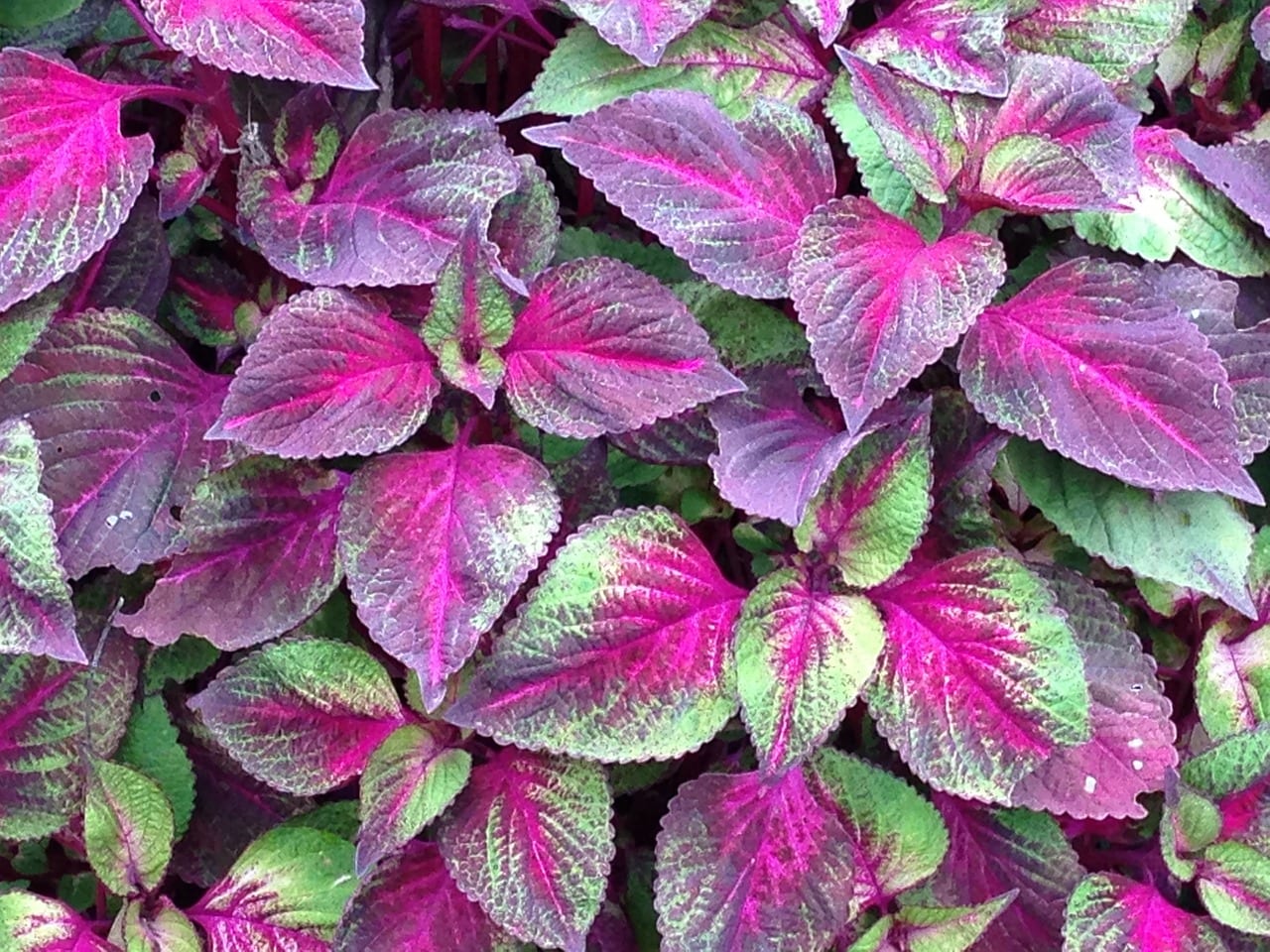How to Make the Most of Perilla Leaf in Your Cooking: Expert Tips and Tricks – Perilla leaf, a vibrant herb with a captivating aroma and a unique flavor profile, is gaining popularity in kitchens worldwide. From its ancient origins in East Asia to its modern culinary applications, perilla leaf offers a world of flavor and nutritional benefits.
Whether you’re a seasoned chef or a home cook looking to expand your culinary horizons, this guide will equip you with the knowledge and techniques to elevate your dishes with the magic of perilla leaf.
This comprehensive guide will delve into the fascinating history, nutritional value, and culinary versatility of perilla leaf. We’ll explore its diverse uses in various cuisines, from traditional Asian dishes to contemporary culinary creations. Discover expert tips and tricks for selecting, storing, and incorporating perilla leaf into your cooking, and explore a collection of mouthwatering recipes that showcase its versatility.
Join us as we unlock the secrets of this captivating herb and unleash its full potential in your culinary endeavors.
Introduction to Perilla Leaf
Perilla leaf, also known as shiso, is a culinary herb with a long and fascinating history. Native to East Asia, this versatile ingredient has been a staple in traditional cuisines for centuries. Its unique flavor profile and nutritional benefits have made it a popular choice for both culinary and medicinal purposes.
Origins and History
Perilla leaf, scientifically known asPerilla frutescens*, originated in East Asia, particularly in regions like China, Japan, and Korea. It has been cultivated for centuries, with records dating back to ancient times. In traditional Chinese medicine, perilla leaf has been used for its medicinal properties, particularly for treating respiratory ailments and digestive issues.
It has also been used as a food source and a flavoring agent in various East Asian cuisines.
Nutritional Value and Health Benefits
Perilla leaf is a nutritional powerhouse, packed with essential vitamins, minerals, and antioxidants. It is a good source of vitamin A, vitamin C, and iron. Perilla leaf is also rich in omega-3 fatty acids, particularly alpha-linolenic acid (ALA), which has been linked to numerous health benefits, including reducing inflammation and improving heart health.
Perilla leaf is also known for its potential to boost the immune system, protect against certain types of cancer, and improve cognitive function.
Flavor Profile and Versatility
Perilla leaf possesses a distinctive flavor profile that is both aromatic and complex. Its taste can be described as a combination of mint, basil, and citrus, with a slightly spicy and peppery undertone. This unique flavor profile makes it a versatile ingredient that can be used in a wide range of culinary applications.
Perilla leaf can be enjoyed fresh, dried, or pickled, and it can be incorporated into various dishes, including salads, soups, stir-fries, and sushi.
Culinary Applications of Perilla Leaf: How To Make The Most Of Perilla Leaf In Your Cooking: Expert Tips And Tricks
Perilla leaf, with its unique flavor profile and versatility, finds a prominent place in various culinary traditions around the world. From traditional Asian dishes to modern fusion cuisine, this herb offers a spectrum of flavors and textures, enhancing both savory and sweet creations.
Dishes Incorporating Perilla Leaf
Perilla leaf’s culinary applications are diverse, lending itself to a wide range of dishes. Here’s a table showcasing traditional and modern recipes that feature perilla leaf:| Dish | Cuisine | Description ||—|—|—|| Bibimbap | Korean | A mixed rice bowl topped with various vegetables, meat, and a fried egg, often garnished with perilla leaf.
|| Kimchi | Korean | Fermented cabbage with a spicy and tangy flavor, often made with perilla leaf for its unique aroma. || Gyoza | Japanese | Pan-fried dumplings filled with various ingredients, often served with a dipping sauce and garnished with perilla leaf.
|| Sushi | Japanese | A popular Japanese dish consisting of vinegared rice topped with various ingredients, including seafood, vegetables, and perilla leaf. || Pad Thai | Thai | Stir-fried rice noodles with various ingredients, including tofu, shrimp, and perilla leaf, often served with lime wedges.
|| Vietnamese Summer Rolls | Vietnamese | Fresh rice paper rolls filled with vegetables, herbs, and sometimes meat, often served with a dipping sauce and garnished with perilla leaf. || Perilla Leaf Salad | Modern | A refreshing salad featuring perilla leaf, other greens, vegetables, and a light vinaigrette.
|| Perilla Leaf Pesto | Modern | A flavorful pesto made with perilla leaf, pine nuts, garlic, and olive oil. || Perilla Leaf Ice Cream | Modern | A unique and refreshing ice cream flavor made with perilla leaf extract.
|
Perilla Leaf as a Culinary Element, How to Make the Most of Perilla Leaf in Your Cooking: Expert Tips and Tricks
Perilla leaf can be incorporated into dishes in various ways, contributing unique flavors and textures:
Garnish
Its vibrant green color and delicate aroma make it an excellent garnish for various dishes, adding a touch of freshness and visual appeal.
Ingredient
Perilla leaf can be used as an ingredient in various dishes, such as salads, stir-fries, and soups, adding a distinct flavor and aroma.
Flavor Enhancer
Perilla leaf can be used to enhance the flavor of dishes, either fresh or dried, adding a unique, complex flavor profile.
Methods of Preparing Perilla Leaf
Perilla leaf can be prepared in several ways, each yielding different flavor profiles and textures:
Fresh
Fresh perilla leaf offers the most vibrant flavor and aroma, often used in salads, garnishes, or as a topping for various dishes.
Dried
Dried perilla leaf retains its flavor and aroma, often used as a seasoning or ingredient in soups and stews.
Pickled
Pickled perilla leaf offers a unique tangy flavor, often used as a condiment or garnish for various dishes.
Infused
Perilla leaf can be infused in oils, vinegars, or alcohols to extract its flavor and aroma, adding a unique twist to sauces, dressings, and drinks.
Expert Tips and Tricks for Using Perilla Leaf

Mastering the art of using perilla leaf in your cooking involves understanding its nuances and employing techniques that enhance its flavor and aroma. This section delves into expert tips and tricks, providing guidance on selecting, storing, and incorporating perilla leaf into your culinary creations.
Selecting Fresh and High-Quality Perilla Leaves
Choosing fresh, high-quality perilla leaves is crucial for achieving optimal flavor and aroma in your dishes. Look for leaves that are vibrant green, free from blemishes, and have a distinct, slightly sweet aroma. Avoid leaves that are wilted, yellowed, or have brown spots, as these indicate signs of spoilage.
The leaves should be firm to the touch and have a slightly crinkled texture.
Storing Perilla Leaves to Preserve Freshness and Flavor
Proper storage is essential for preserving the freshness and flavor of perilla leaves. To maintain their quality, store them in a sealed container or plastic bag in the refrigerator. For longer storage, you can freeze perilla leaves by blanching them briefly in boiling water for about 30 seconds, then shock them in ice water.
Once drained, pat them dry and store them in freezer-safe bags.
Essential Cooking Techniques for Incorporating Perilla Leaf into Dishes
Incorporating perilla leaf into dishes requires understanding the right techniques to maximize its flavor and aroma. Here are some essential cooking techniques to consider:
- Adding Fresh Perilla Leaves:Fresh perilla leaves are best added at the end of cooking to retain their vibrant flavor and aroma. They can be used as a garnish, tossed into salads, or added to stir-fries and soups.
- Infusing Flavor:Perilla leaves can be used to infuse flavor into oils, vinegars, and sauces. Simply steep the leaves in the desired liquid for several hours or overnight. This technique imparts a unique and delicate perilla flavor to your dishes.
- Grilling or Roasting:Grilling or roasting perilla leaves brings out their natural sweetness and adds a smoky flavor. This technique is particularly well-suited for adding a touch of complexity to grilled meats, fish, or vegetables.
- Making Perilla Paste:Perilla paste can be made by blending fresh perilla leaves with salt, garlic, and other ingredients. This paste can be used as a condiment, spread, or marinade, adding a vibrant and pungent flavor to dishes.
Recipes Featuring Perilla Leaf
Perilla leaf, with its unique flavor profile and versatility, lends itself to a wide range of culinary applications. From appetizers to main courses and even desserts, this herb can elevate your dishes with its distinct aroma and taste. Explore the diverse culinary possibilities of perilla leaf with these recipes, each designed to showcase its unique qualities.
Appetizers
Perilla leaf’s vibrant flavor and aroma make it an excellent addition to appetizers. Here are a few recipes that highlight its versatility in this culinary category.
- Perilla Leaf and Shrimp Spring Rolls: These spring rolls are a light and refreshing appetizer that showcases the bright, slightly minty flavor of perilla leaf.
- Ingredients:
- Rice paper wrappers
- Cooked shrimp
- Shredded carrots
- Fresh perilla leaves
- Rice noodles
- Soy sauce
- Rice vinegar
- Sesame oil
- Sugar
- Instructions:
- Soak rice paper wrappers in warm water until softened.
- Fill each wrapper with shrimp, carrots, perilla leaves, and rice noodles.
- Roll tightly and serve with a dipping sauce made with soy sauce, rice vinegar, sesame oil, and sugar.
- Ingredients:
- Perilla Leaf and Sesame Seed Crackers: These crispy crackers are a delightful snack that combines the savory notes of sesame seeds with the refreshing aroma of perilla leaf.
- Ingredients:
- All-purpose flour
- Sesame seeds
- Dried perilla leaves
- Salt
- Olive oil
- Instructions:
- Combine flour, sesame seeds, dried perilla leaves, and salt in a bowl.
- Gradually add olive oil and knead until a dough forms.
- Roll out the dough and cut into desired shapes.
- Bake in a preheated oven until golden brown and crispy.
- Ingredients:
Salads
Perilla leaf’s refreshing taste and vibrant color make it an ideal ingredient for salads. Its unique flavor complements a variety of ingredients, adding depth and complexity to your salads.
- Perilla Leaf and Cucumber Salad: This simple yet refreshing salad combines the crispness of cucumber with the refreshing aroma of perilla leaf.
- Ingredients:
- Sliced cucumbers
- Fresh perilla leaves
- Rice vinegar
- Soy sauce
- Sesame oil
- Sugar
- Instructions:
- Combine sliced cucumbers and perilla leaves in a bowl.
- Whisk together rice vinegar, soy sauce, sesame oil, and sugar to make a dressing.
- Pour dressing over the salad and toss to coat.
- Ingredients:
- Perilla Leaf and Grilled Chicken Salad: This salad combines the smoky flavor of grilled chicken with the refreshing taste of perilla leaf, creating a delicious and satisfying meal.
- Ingredients:
- Grilled chicken breast, sliced
- Mixed greens
- Fresh perilla leaves
- Cherry tomatoes, halved
- Red onion, thinly sliced
- Olive oil
- Lemon juice
- Salt and pepper
- Instructions:
- Combine mixed greens, perilla leaves, cherry tomatoes, and red onion in a large bowl.
- Whisk together olive oil, lemon juice, salt, and pepper to make a dressing.
- Pour dressing over the salad and toss to coat.
- Top with grilled chicken breast and serve.
- Ingredients:
Main Courses
Perilla leaf’s unique flavor profile can elevate your main courses, adding a touch of freshness and complexity. Here are a few recipes that demonstrate its versatility in this culinary category.
- Perilla Leaf and Pork Stir-Fry: This stir-fry combines the savory flavor of pork with the refreshing taste of perilla leaf, creating a flavorful and satisfying dish.
- Ingredients:
- Thinly sliced pork
- Bell peppers, sliced
- Onions, sliced
- Garlic, minced
- Fresh perilla leaves
- Soy sauce
- Oyster sauce
- Sesame oil
- Sugar
- Cornstarch
- Instructions:
- Marinate pork in a mixture of soy sauce, oyster sauce, sesame oil, sugar, and cornstarch.
- Heat sesame oil in a wok or large skillet over high heat.
- Add pork and stir-fry until browned.
- Add bell peppers, onions, and garlic and stir-fry until softened.
- Stir in perilla leaves and cook for a few minutes until wilted.
- Serve over rice or noodles.
- Ingredients:
- Perilla Leaf and Salmon with Ginger Glaze: This dish combines the delicate flavor of salmon with the refreshing taste of perilla leaf and a fragrant ginger glaze.
- Ingredients:
- Salmon fillets
- Fresh perilla leaves
- Ginger, grated
- Soy sauce
- Mirin
- Sugar
- Sesame oil
- Instructions:
- Combine grated ginger, soy sauce, mirin, sugar, and sesame oil in a small bowl to make a glaze.
- Place salmon fillets on a baking sheet and brush with the glaze.
- Bake in a preheated oven until cooked through.
- Garnish with fresh perilla leaves and serve.
- Ingredients:
Desserts
Perilla leaf’s unique flavor can even enhance desserts, adding a refreshing twist to traditional sweets. Here are a few recipes that showcase its versatility in this culinary category.
- Perilla Leaf and Mango Ice Cream: This ice cream combines the sweetness of mango with the refreshing aroma of perilla leaf, creating a unique and delicious dessert.
- Ingredients:
- Mango, peeled and diced
- Heavy cream
- Condensed milk
- Fresh perilla leaves
- Instructions:
- Blend mango, heavy cream, condensed milk, and perilla leaves until smooth.
- Pour the mixture into an ice cream maker and churn according to the manufacturer’s instructions.
- Freeze the ice cream for at least 2 hours before serving.
- Ingredients:
- Perilla Leaf and Green Tea Cookies: These cookies combine the earthy flavor of green tea with the refreshing aroma of perilla leaf, creating a unique and delightful treat.
- Ingredients:
- All-purpose flour
- Butter, softened
- Sugar
- Green tea powder
- Dried perilla leaves
- Eggs
- Instructions:
- Cream together butter and sugar until light and fluffy.
- Beat in eggs one at a time.
- Gradually add flour, green tea powder, and dried perilla leaves.
- Drop by rounded tablespoons onto ungreased baking sheets.
- Bake in a preheated oven until golden brown.
- Ingredients:
Perilla Leaf in Different Cultures
Perilla leaf, with its unique flavor and aroma, has been a staple ingredient in various cuisines around the world for centuries. Its culinary use and cultural significance vary greatly across different regions, reflecting the diverse ways in which people have incorporated this versatile herb into their culinary traditions.
Culinary Uses of Perilla Leaf Across the Globe
Perilla leaf’s versatility is evident in its diverse culinary applications across different cultures. It is used in various ways, from fresh garnishes to essential ingredients in complex dishes.
While perilla leaf adds a unique flavor and aroma to Asian cuisine, its versatility extends beyond the kitchen. Its vibrant hues make it a perfect ingredient for crafting eye-catching autumn decorations. For inspiration, check out this guide on DIY Fall Decor: How to Make an Eye-Catching Autumn Leaf Garland , which showcases the beauty of perilla leaves in a decorative context.
Once you’ve enjoyed the visual appeal, bring the perilla leaf back to the kitchen and explore its diverse culinary uses.
- East Asia:Perilla leaf is a popular ingredient in East Asian cuisines, particularly in Korea, Japan, and China. In Korean cuisine, it is known as “gae” and is often used as a garnish for grilled meats, such as bulgogi, and in stews like kimchi jjigae.
Japanese cuisine uses perilla leaf, known as “shiso,” in various dishes, including sushi, tempura, and pickled vegetables. In Chinese cuisine, perilla leaf, called “zi su,” is used in stir-fries, soups, and as a flavoring agent for meat and seafood.
- Southeast Asia:Perilla leaf also finds its way into Southeast Asian cuisines, particularly in Vietnam and Thailand. In Vietnamese cuisine, it is known as “lá tía tô” and is used in salads, soups, and as a fragrant garnish for various dishes. In Thai cuisine, perilla leaf, called “bai horapa,” is often used in stir-fries, curries, and as a fresh ingredient in salads.
- Western Cuisine:While less common in Western cuisine, perilla leaf is gaining popularity as a unique flavoring agent. Its distinct aroma and slightly peppery taste complement various dishes, including salads, pasta, and grilled meats.
Cultural Significance and Traditional Uses of Perilla Leaf
Beyond its culinary uses, perilla leaf holds significant cultural importance in various regions.
- Korea:In Korea, perilla leaf is believed to have medicinal properties and is used in traditional medicine to treat respiratory ailments and digestive problems. It is also considered a symbol of longevity and good health.
- Japan:In Japan, perilla leaf is associated with summer and is often used in traditional festivals and celebrations. It is also believed to have purifying properties and is used in religious ceremonies.
- China:In China, perilla leaf is used in traditional medicine to treat various ailments, including headaches, colds, and indigestion. It is also believed to have calming and relaxing properties.
Specific Dishes and Culinary Traditions Featuring Perilla Leaf
Perilla leaf plays a prominent role in numerous dishes and culinary traditions around the world.
- Korean Kimchi:Kimchi, a fermented Korean dish made with cabbage, is often flavored with perilla leaf, adding a distinct aroma and spicy kick.
- Japanese Shiso Maki:Shiso maki, a type of sushi roll, features perilla leaf as a key ingredient, providing a unique flavor and aroma that complements the rice and fillings.
- Vietnamese Goi Cuon:Goi cuon, Vietnamese fresh spring rolls, often include perilla leaf as a fresh ingredient, adding a refreshing and aromatic element to the dish.
Perilla Leaf and its Health Benefits

Perilla leaf, a member of the mint family, is not only a culinary delight but also a treasure trove of health-promoting compounds. Its vibrant green leaves are packed with essential nutrients and potent antioxidants, making it a valuable addition to a healthy diet.
Nutritional Value of Perilla Leaf
Perilla leaf boasts an impressive nutritional profile, providing a range of vitamins, minerals, and antioxidants.
- Vitamins:Rich in vitamin A, vitamin C, and vitamin K, which are crucial for maintaining healthy vision, boosting immunity, and supporting blood clotting, respectively.
- Minerals:A good source of minerals like calcium, iron, and magnesium, essential for bone health, red blood cell production, and muscle function.
- Antioxidants:Contains high levels of antioxidants, including rosmarinic acid, perillaldehyde, and luteolin, which protect cells from damage caused by free radicals.
Potential Health Benefits of Perilla Leaf
Beyond its nutritional value, perilla leaf has been associated with various health benefits, supported by scientific research.
- Anti-inflammatory Properties:Perilla leaf contains compounds like rosmarinic acid, which exhibit potent anti-inflammatory effects. These properties may help reduce inflammation associated with conditions like arthritis and asthma.
- Antiviral Activity:Studies have shown that perillaldehyde, a compound found in perilla leaf, possesses antiviral activity against certain viruses, including influenza virus.
- Anti-cancer Potential:Some research suggests that perilla leaf extracts may have anti-cancer properties, potentially inhibiting the growth and spread of cancer cells. Further research is needed to confirm these findings.
Research Findings and Studies
Several studies have investigated the health benefits of perilla leaf consumption.
From adding a unique flavor to your dishes to incorporating it into refreshing summer drinks, perilla leaf offers a wealth of culinary possibilities. But to truly unlock its potential, understanding how to grow and harvest this versatile herb is crucial.
For a comprehensive guide on cultivating perilla leaf at home, check out our article on How to Grow and Cook with Perilla Leaf: Essential Tips for Home Cooks. Once you have your own supply, you can experiment with different culinary techniques, like using it as a garnish, incorporating it into stir-fries, or even creating flavorful sauces.
- Anti-inflammatory Effects:A study published in the journal “Food and Chemical Toxicology” found that rosmarinic acid, a major component of perilla leaf, significantly reduced inflammation in animal models.
- Antiviral Activity:Research published in the “Journal of Ethnopharmacology” demonstrated the antiviral activity of perillaldehyde against influenza virus in cell culture studies.
- Anti-cancer Properties:A study published in the journal “Cancer Letters” suggested that perilla leaf extracts may inhibit the growth of human breast cancer cells.
Conclusion
Perilla leaf, with its unique flavor profile and versatility, offers a world of culinary possibilities. From its use as a garnish to its starring role in various dishes, perilla leaf can elevate your cooking experience. Its adaptability allows it to complement a wide range of cuisines and flavors, adding depth and complexity to your creations.
Whether you’re seeking a vibrant green hue, a refreshing minty aroma, or a touch of nutty bitterness, perilla leaf has something to offer. This article has explored the diverse culinary applications of perilla leaf, providing expert tips and tricks for incorporating it into your dishes.
By experimenting with different preparations and flavor combinations, you can discover the full potential of this remarkable herb.
Closing Notes

With its vibrant flavor, nutritional richness, and culinary versatility, perilla leaf is a culinary gem waiting to be discovered. Whether you’re adding a touch of freshness to a salad, infusing a savory sauce, or creating a unique dessert, perilla leaf offers a world of possibilities.
Embrace the adventure of experimenting with this remarkable herb and let its captivating flavors transform your culinary creations. From traditional Asian dishes to modern culinary innovations, perilla leaf invites you to explore a world of flavor and unlock its full potential in your kitchen.
FAQ Compilation
What is the best way to store perilla leaf to preserve its freshness?
Store fresh perilla leaves in a plastic bag lined with a damp paper towel and refrigerate for up to a week. For longer storage, consider freezing them in a freezer-safe bag.
Can I use perilla leaf in desserts?
Yes, perilla leaf can add a unique and refreshing twist to desserts. It pairs well with fruits, chocolate, and creamy textures.
What are some substitutes for perilla leaf if I can’t find it?
Shiso leaf is a close relative of perilla leaf and can be used as a substitute. Other options include basil, mint, or cilantro, depending on the desired flavor profile.
